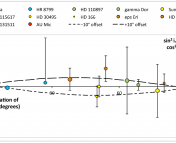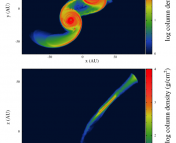- Title: Impact of planet-planet scattering on the formation and survival of debris disks
- Author: F. Marzari
- First Author’s Institution: University of Padova, Italy
- Status: Accepted for publication in MNRAS
A large fraction of the exoplanet systems we observe have one or more planets on highly eccentric orbits but fairly small semimajor axes. One proposed mechanism for this configuration is planet-planet scattering, in which the orbits of two planet cross, and repeated close encounters between the two planets cause chaotic changes in their orbits. This usually ends with one planet ejected from the system and the other in a stable but eccentric orbit, close to its star.
What effect does this kind of disruptive event have on the rest of the system, like the planetesimals? Planetesimals are large chunks of ice and rock left over after planet formation. They are smaller and cooler than planets, so they are very difficult to observe. However, planetesimals on intersecting orbits will smash into each other, breaking into lots of tiny dust grains that we can observe in the infrared. We call this disk of planetesimals and dust a debris disk, but we can only observe the small dust grains, and they are only produced by collisions between the planetesimals. We know debris disks in systems with planets can survive periods of planet migration. For example, our own Kuiper Belt was sculpted but not destroyed by the outward migration of Neptune and Uranus. But what happens when the planets go through a sudden, chaotic change in orbits during planet-planet scattering? Should we expect to see a lot of debris disks in these systems, or very few?
The authors of this paper use numerical simulations to study the effects of this planet-planet scattering on any planetesimals unlucky enough to be in the way. Their goal was to determine if enough planetesimals would remain after the scattering event to replenish the dust in the system through collisions and produce an observable debris disk.
The authors simulated a system with three Jupiter-sized planets on near-circular orbits and a planetesimal belt. They performed over 50 simulations, varying the masses of the planets and the initial locations of the planetesimal belts. In each simulation, one planet was ejected while the other two remained in the system. The authors observed several different outcomes.

Fig. 1: Final eccentricities and semimajor axis of the surviving planets (big purple dots) and planetesimals (red and green dots). The blue line shows the initial distribution of planetesimals. The red dot planetesimals are on planet-crossing orbits and will soon be ejected. The green dot planetesimals are on stable orbits. In this simulation, the scattering event lasted long enough to scatter most of the planetesimals. (Fig. 1a in Marzari 2014)
Some simulations ended with no debris disk. About 5% of the planetesimals remained in the system, but they were so dispersed in highly eccentric orbits that they were extremely unlikely to collide and produce any observable dust. This outcome tended to occur after a long planet-planet scattering event lasting about 2 million years, or when the outer of the two surviving planets ended up on a very eccentric orbit, taking it through the planetesimal belt and ejecting most of the planetesimals. Figs. 1 and 2 show the eccentricities and semimajor axes of the surviving planetesimals in each of these two types of simulations.

Fig. 2: Same as Fig. 1, but in this simulations the outer surviving planet has a very high eccentricity and ejects most of the planetesimals. (Fig. 2a in Marzari 2014)
In other simulations, the third planet was ejected very quickly and the remaining planets had low eccentricities. In these systems, the planetesimals were stirred up enough to begin colliding and producing dust, but most still remained in the system. This created a nicely observable belt of dust, especially if the initial planetesimal belt was placed in the outer part of the system. Fig. 3 shows the eccentricities and semimajor axes of the planetesimals in this simulation. Notice that most of the planetesimals are on eccentric but stable orbits.

Fig. 3: Same as Figs. 1 and 2, but here the scattering event is short enough that the planetesimal belt survives, with some excited eccentricities. (Fig. 3a in Marzari 2014)
In other cases, the planet-planet scattering phase was so short (about a thousand years) that the amount of excitation in the planetesimal belt was negligible. These planetesimals would need other stirring mechanisms (like secular or resonant perturbations) to produce enough dust to be observable.
So to create and keep a debris disk, you need the scattering event to last long enough to stir the planetesimals, but not so long that the disk is completely scattered away. You also need the outer surviving planet to have a not-too-eccentric orbit. Planet-planet scattering events are chaotic, so by definition we cannot predict the outcome of the planetesimal belt based on the initial conditions of the system. However, the authors were able to analyze their results statistically and calculate the probability of the different outcomes. They found that about 60-90% of their systems lost their planetesimal belts. They also found that starting the planets further from the start increased the likelihood that the planetesimal belt would be destroyed.
What testable predictions do these simulations make? The authors conclude that about 60-90% of systems in which planet-planet scattering has occurred should have lost their planetesimal belts, so we should see a lower rate of debris disks in systems where we see at least one planet on a highly eccentric orbit. The authors also recommend more simulations with different numbers of planet to study this topic further.





Trackbacks/Pingbacks